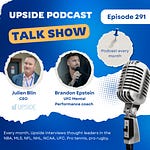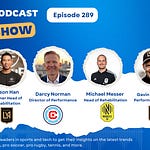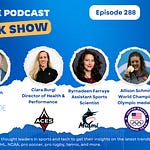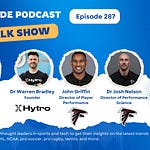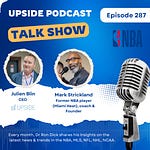This week we had the honor to interview a group of NCAA sports performance experts.
Dr. John DeWitt, director of applied sports science in the athletic department and a faculty member, Rice University (NCAA team).
Eric Renaghan, Executive Director of Sport Performance, University of Miami (NCAA team).
Drew Lukes, Senior PT at Duke University and the head of sports science, Duke university’s women soccer team (NCAA team).
Brandon DeSantis, Director of Integrated Health and Sports Performance, James Madison University (NCAA team).
You can read the full transcript of the podcast interview with Eric, Drew, John and Brandon located at the top of this blog post.
Here are some of the best quotes of our conversation with them:
Q1. Collaboration Strategies
Eric Renaghan: "For me, good communication is the centerpiece of collaboration. In sports science, our department has acted as a conduit between rehabilitation, nutrition, sports performance, and football operations by connecting data collection across different areas. Success has come from asking the right questions—both solving existing problems and uncovering new ones through data evaluation. When communication is strong, collaboration becomes much easier."
Drew Lukes: "From my perspective, soft skills—especially humility and a lack of ego—are crucial. When ego is present in a room, collaboration often takes a backseat. I love how technology, as John mentioned, has made it easier to communicate across a vast organization and among teams. But at the core of it all, humility is essential. Technology can facilitate communication, but if the people behind it aren’t willing to learn from each other and grow through interaction, its impact is limited."
Dr. John DeWitt: "The part that's really important in collaboration is two-way conversation to develop relationships and solve problems together in a way that's meaningful for the coaches while leveraging technology and data. When I first came on, sports science was being used heavily by all of the teams, but everybody was doing their own thing. I was able to take code or processes from one team and put them into another, leveraging best practices across the university. Communication, shared collaboration, and bridging sports are all really important. It helps everyone see that we're working as a program, not just as a bunch of individual teams that happen to wear the same color t-shirt."
Brandon DeSantis: “As far as enhancing collaboration goes between coaching staff members and medical and performance team members, I think first and foremost it is recognizing that everyone wants the same thing. Everyone wants the student-athletes to be healthy and available for competition- we also want to win! One thing we have done here is establish performance meetings; a way for all of our stakeholders to meet, discuss our student-athletes, and ensure that our higher risk student-athletes get the resources that they need. These stakeholders include the athletic trainers, strength and conditioning coaches, dietitians, sport psychologists, academic advisors, sport supervisors, and coaches. Getting everyone together allows us to be on the same page and ensure that no one slips through the cracks. This has helped us develop stronger relationships as a united group.”
Q2. Startups & NCAA Programs
Eric Renaghan: "We've worked with both startups and well-established companies, and reliability isn’t just a startup issue—some established companies fail to deliver on what they promise, despite charging six figures. Organizations like universities need to set high standards when working with these companies, especially when using student-athlete data to develop and refine technology. The key questions are: Does this tool or software truly help answer our questions or fill gaps in our capabilities? And if it's new, can we access and validate the data to ensure it provides the insights it claims to? These standards should apply equally to both emerging and long-standing companies in sports technology."
Dr. John DeWitt: "At Rice, we have many bright, young students eager to break into sports, and I often get approached by those developing new garments or tech. I enjoy mentoring them, helping refine their ideas by asking: ‘Does this solve a real problem?’ If it does, I offer guidance on next steps; if not, I encourage them to seek other perspectives. I take a hands-on approach, preferring to test early-stage tech rather than waiting for a perfect product. Like Eric mentioned, technology must answer meaningful questions—cool gadgets that provide irrelevant data only waste our time and that of our student-athletes. While some benefits only become clear after implementation, we carefully vet new tech to ensure it enhances the student-athlete experience. If it's a startup, we’re open to collaboration, but only if it truly adds value."
Brandon DeSantis: "The biggest factor when adopting technology is understanding your budget—every school has different resources and philosophies. Any technology you invest in should provide real value, and if you're spending money on it, you need to use it effectively. Startups sometimes offer discounted rates to gain clients, but the technology must still be a good fit for your program. It’s important to be budget-conscious while staying open-minded. With so many new companies and innovations emerging, listening to vendors—whether you agree with them or not—can help drive your organization forward."
Q3. NIL Impact on Athlete Performance & Training
Eric Renaghan: "My perspective is shaped by spending a decade in the NHL before moving to college sports. At the professional level, players are often on one-year contracts, but in college football, the NIL era has created an even more unpredictable landscape with multiple free agency windows through the transfer portal. Now, teams not only recruit new players but must also re-recruit their own roster to keep them from being lured away by other programs offering better opportunities. This makes college athletics feel more like pro sports than ever before. From a branding perspective, our university does a great job supporting athletes in building their personal brands, leveraging the school’s national and global recognition. On the performance side, the focus has shifted—rather than developing athletes over four years, the priority is ensuring they perform at their best and stay healthy for the current season."
Drew Lukes: "It’s almost like we’re starting to fit a professional model into a scaffolding that wasn’t created for [a] professional model up to this point. Just thinking about all of the resources of support and people they have around them to deal with contracts, agents, and particular deals… I feel like here, although it’s starting because we’ve had to, I think we’re behind. NIL definitely disproportionately affects different sports, and where I spend most of my time in Olympic sports, the money is a lot less, and I think it’s gonna be slower to catch up than football and basketball. My first few years here, I was always rehabbing people from season-ending injuries to get back to our team. Now, that’s not necessarily the case—often, I’m rehabbing people because they’re in discussions to transfer or leave early to go pro. So it’s setting them up for the environment they’re going into rather than the one they’re currently in, which has been a mind shift and a challenge for me as well”.
Dr. John DeWitt: "At our university, NIL has had less impact compared to others, but it’s still shifted the landscape, especially with players acting like free agents. We get a lot of graduate transfers, particularly in our Olympic sports, and we’ve had to adjust by using data to create forecast models. We analyze the typical trends of athletes over four years and apply that to transfers to assess their potential—whether they’re at their peak or still have untapped growth. This is where NIL affects us the most: in evaluating transfers and managing players within a model that mirrors the professional sports world, but with the limitation of playing only a set number of years before being 'kicked out,' which is a unique challenge for us."
Brandon DeSantis: "NIL is here, and universities need to lean into it to maximize success, but there must be guardrails in place. It's crucial to ensure that student-athletes aren't endorsing products that violate policies, such as drug testing or supplement regulations. The responsibility lies with the university and staff to monitor, educate, and guide student-athletes in their decision-making. While NIL hasn't caused major changes in our training programs, our focus is on helping athletes make smart, appropriate choices to protect their playing status and overall health, both physically and mentally."
Q4. Great NCAA Coaches & Their Philosophies
Eric Renaghan: "Great coaches are lifelong learners who are always open to new ways of doing things. The most successful coaches are those who adapt to new information, whether from data or staff, and apply it to improve their coaching, the athletes' performance, and the overall organization. Effective communication is key in this process, as it helps motivate athletes and build compliance. When athletes understand the purpose behind certain practices, like thermal imaging or using force plates, they are more likely to buy into these methods. This knowledge-driven approach not only improves outcomes but also fosters better relationships and a more effective coaching environment”.
Drew Lukes: "The most successful coaches are those who are willing to critically assess their methods, make adjustments, and continuously evolve. Coaches who trust their support staff, delegate responsibilities, and hire the right people tend to build successful teams. By giving their staff the space to excel in their areas of expertise, these coaches create an environment where everyone can contribute, ultimately leading to greater success”.
Dr. John DeWitt: "The best coaches view their role as an opportunity to improve both athletes' skills and their lives. They build relationships, show compassion, and set high standards, but also know when to part ways with athletes who aren't meeting expectations. On the other hand, successful coaches see support staff and external experts as opportunities to enhance their program, not threats. They are open to feedback and willing to collaborate with others, as long as the expertise is trusted, rather than isolating themselves and rejecting outside help. This open-mindedness and willingness to listen are key qualities of great coaches”.
Brandon DeSantis: "Great coaches are also great leaders and teachers who focus on developing the whole person, not just the athlete. While winning is critical, the best coaches understand that success comes from guiding student-athletes to become well-rounded adults. They emphasize the importance of academics, recovery techniques like sleep, and making smart decisions off the field. These coaches also effectively utilize university resources, both within and outside of athletics, to enhance their athletes' overall experience. Innovation and strong relationships with athletes and support staff are key to creating a unified, successful environment”.
Q6. Managing Student-Athlete Expectations & Motivation
Eric Renaghan: "The concept of pressure is viewed as a privilege, as it reflects the demand for excellence. Strategies developed to handle pressure in sports, like football, can be applied beyond the field, such as in medical or military careers, where the pressure may be even greater. The skills athletes learn under pressure, including resilience and performance, can be valuable in any career”. (..) "We emphasize to our athletes that the skills they develop as high performers in sports can open doors in other fields, like business or any civilian career. Being a successful former athlete—whether from Division I, II, or III—can present unique opportunities that others may not have access to. It's important for athletes to view their experience holistically, recognizing how their performance skills translate beyond just sports."
Drew Lukes: "In a rehab setting, particularly with athletes recovering from significant injuries like an ACL tear, there are often deep reflections on the role of sports in their lives. These athletes frequently question whether they want to invest the effort needed to return to their sport, and this presents a unique opportunity to discuss life beyond athletics. Conversations often shift to whether they have backup plans or other passions outside of their sport, which can be rewarding. These discussions also highlight how the skills athletes develop in their sport can be applied to various aspects of life after their athletic careers”.
Dr. John DeWitt: "The concept of high performance isn't limited to sports; it can be applied to any field, whether it's becoming a professional athlete, a lawyer, a doctor, or a business owner. While preparing athletes for careers in the NFL or NBA might involve specific performance-related advice, the core of high performance lies in developing traits like resilience—being able to get knocked down and keep going. Whether working with athletes or others, the goal is to help individuals become high performers, instilling traits that transcend sports and apply to all aspects of life”.
Brandon DeSantis: "The key to supporting student athletes is understanding their individual values and goals, whether it's pursuing a professional career in sport or transitioning to life beyond athletics. As support staff, our role is to tailor our approach to each athlete's unique needs, balancing accountability with empathy. Some athletes may need more encouragement, while others require a gentler approach. Ultimately, recognizing their personality and aligning on goals is crucial to avoid confusion and ensure effective support”.
You may also like:
🔥Upside Chat with Andrea Hudy (UCONN/NCAA), Drew Lukes (Duke University/NCAA), Michael Messer (Nashville SC/MLS) on Commonalities & Differences Between the NCAA & MLS.
This week we had the honor to interview again a group of sports performance experts.





